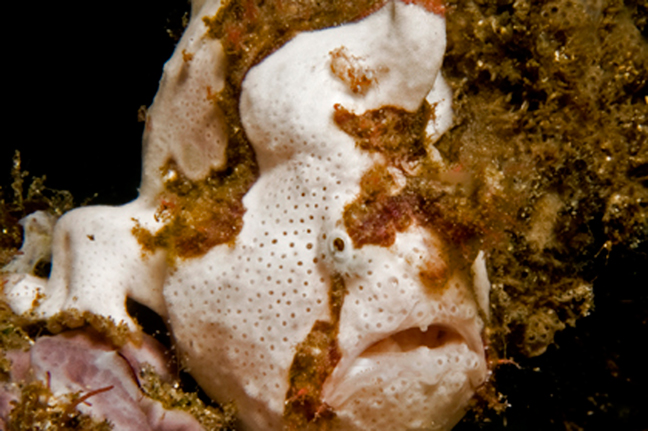Warty Anglerfish, Antennarius maculatus (Desjardins 1840)

Warty Anglerfish, Antennarius maculatus photographed in Northern Sulawesi, Indonesia. Source: Dave Harasti / http://www.daveharasti.com/. License: All rights reserved
Head, body and fins covered in prominent wart-like protuberances. Colour highly variable to match the surroundings - ranging from shades of cream, pink, red, to yellow, green, brown and black, often with darker pale-bordered spots, darker patches and saddles.
Warty Anglerfish live amongst macroalgae, sponges and soft corals.
Warty Anglerfish, Antennarius maculatus (Desjardins 1840)
More Info
|
Distribution |
Widespread in the tropical Indo-Pacific, from the eastern Indian Ocean to Hawaii, north to Japan and south to Queensland, Australia. Warty Anglerfish inhabit coastal reefs, usually amongst macroalgae, sponges and soft corals in depths to 15 m. |
|
Features |
Meristic features: Dorsal fin I + I + I, 12 (rarely 11); Anal fin 7 (rarely 6); Pectoral fin 10 (rarely 11). Head, body and fins with many prominent wart-like protuberances on skin; bony part of illicium with numerous crossbands, approximately twice as long as second dorsal-fin spine; esca large, strongly resembling a tiny fish. Scales absent, skin covered in close-set bifurcated spinules. Fins: Second dorsal-fin spine curved posteriorly, expanded from base, appearing swollen; membrane behind thin (width along spine attachment distinctly less than that of spine itself), nearly always devoid of dermal spinules, and extending across area between 2nd and 3rd dorsal-fin spines reaching base of 3rd fin spine. Pectoral fins prehensile with an elbow-like joint; pelvic fins with a short, slender spine and 5 soft rays. |
|
Size |
To 9 cm. |
|
Colour |
Highly variable, ranging from cream, yellow, greenish yellow, chocolate-brown, to black, with numerous, scattered, circular spots and saddles or blotches of various sizes. Saddles, spots and blotches range from white, pink red, or rusty-brown. Esca with an, eye-like pigment spot on each side near base, mottled with white and chocolate brown or 5 darkly pigmented vertical bands immediately posterior to "eye-spot". All fins usually with red or orange margins and the first saddle extends from the posterior edge of the eye. In preservative, creamy white, light pinkish grey, yellow, brown, dark brown, to almost black. Illicium lightly banded in some specimens; 0-9 short, darkly pigmented bars radiating from eye. |
|
Feeding |
Warty Anglerfish are carnivores and feed mostly on other fishes. These ambush predators lie motionless and wriggle their lure to attract and rapidly engulf unsuspecting prey. |
|
Biology |
Reproduction: Oviparous, sexes separate with external fertilization. Pelagic eggs are produced in a gelatinous floating mass or 'raft' where they remain embedded until hatching. Pelagic larvae remain in the plankton for one to two months before settling onto the reef. |
|
Fisheries |
Although of no interest to fisheries, Warty Anglerfish have been collected for trade in the Aquarium Industry. |
|
Conservation |
IUCN Red List: Not evaluated EPBC Act 1999: Not listed |
|
Remarks |
Small juveniles are often whitish in colour with reddish-brown saddle markings and an orange border to the dorsal and caudal fins. |
|
Similar Species |
Although similar to Antennarius pictus, the Warty Anglerfish has much larger and more conspicuous warts and bumps on the fins and body. The 2nd dorsal-fin spine is club-shaped in A. maculatus, whereas it tapers from the base to the tip in A. pictus. The membrane connecting the 2nd dorsal-fin spine to the head is smaller in A. maculatus. In A. pictus, the membrane extends from the tip of the 2nd dorsal-fin spine to the base of the 3rd dorsal-fin spine. |
|
Etymology |
Antennarius is from the Latin, antenna, meaning sensory organ, in reference to the modified first dorsal-fin spine. |
|
Species Citation |
Chironectes maculatus Desjardins 1840, Chironecte. Mag. Zool. 1839: 1, Pl. 1, Mauritius. |
|
Author |
Dianne J. Bray & Vanessa J. Thompson |
Warty Anglerfish, Antennarius maculatus (Desjardins 1840)
References
Allen G.R. (1997) Marine Fishes of tropical Australia and South-east Asia: A field Guide for Anglers and Divers. Western Australia 292pp.
Allen, G.R., N.J. Cross, D.J. Bray & D.F. Hoese 2006. Antennariidae. pp. 637-646 in Beesley, P.L. & Wells, A. (eds). Zoological Catalogue of Australia. Volume 35 Australia : ABRS & CSIRO Publishing Parts 1-3 2178 pp.
Arnold, R.J. & T.W. Pietsch 2012. Evolutionary history of frogfishes (Teleostei: Lophiiformes: Antennariidae): A molecular approach. Molecular Phylogenetics and Evolution 62: 117-129.
Desjardins, J. 1840. Description d'une nouvelle espèce de l'île Maurice, appartenant à la famille des Pectorales pédiculées et au genre Chironecte. Magasin de Zoologie (Paris) 1839: 1-4
Kuiter, R.H. 1996. Guide to sea fishes of Australia. A comprehensive reference for divers and fishermen. Sydney, NSW, Australia : New Holland Publishers xvii, 434 pp.
Michael, S.W. (1998). Reef Fishes Volume 1. A Guide to Their Identification, Behaviour and Captive Care. Microcosm Ltd. Shellbourne, Vermont 624 pp.
Pietsch, T.W. 1984. The genera of frogfishes (family Antennariidae). Copeia 1984(1): 27-44 fig. 1
Pietsch, T.W. 1999. Families Antennariidae, Tetrabrachiidae, Lophichthyidae. pp. 2013-2019 in Carpenter, K.E. & Niem, V.H. (eds). The Living Marine Resources of the Western Central Pacific. FAO Species Identification Guide for Fisheries Purposes. Rome : FAO Vol. 3 1397-2068 pp.
Pietsch, T.W. & Grobecker, D.B. 1987. Frogfishes of the World: Systematics, Zoogeography, and Behavioral Ecology. Palo Alto : Stanford University Press 420 pp.
Randall J.E. (2005). Reef and Shore Fishes of the South Pacific. University of Hawaii Press, Honolulu. 707pp.








